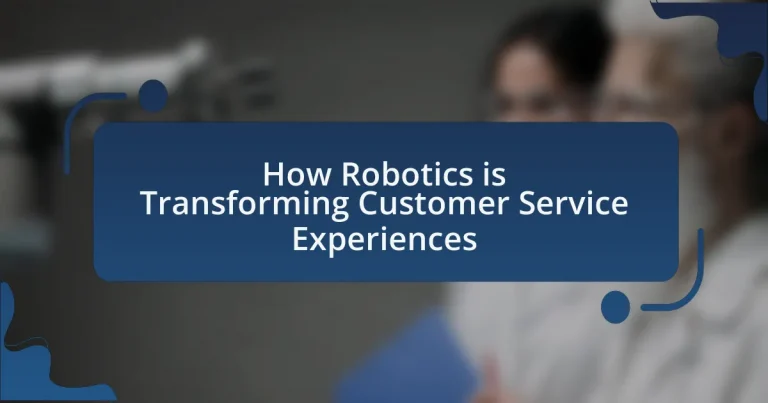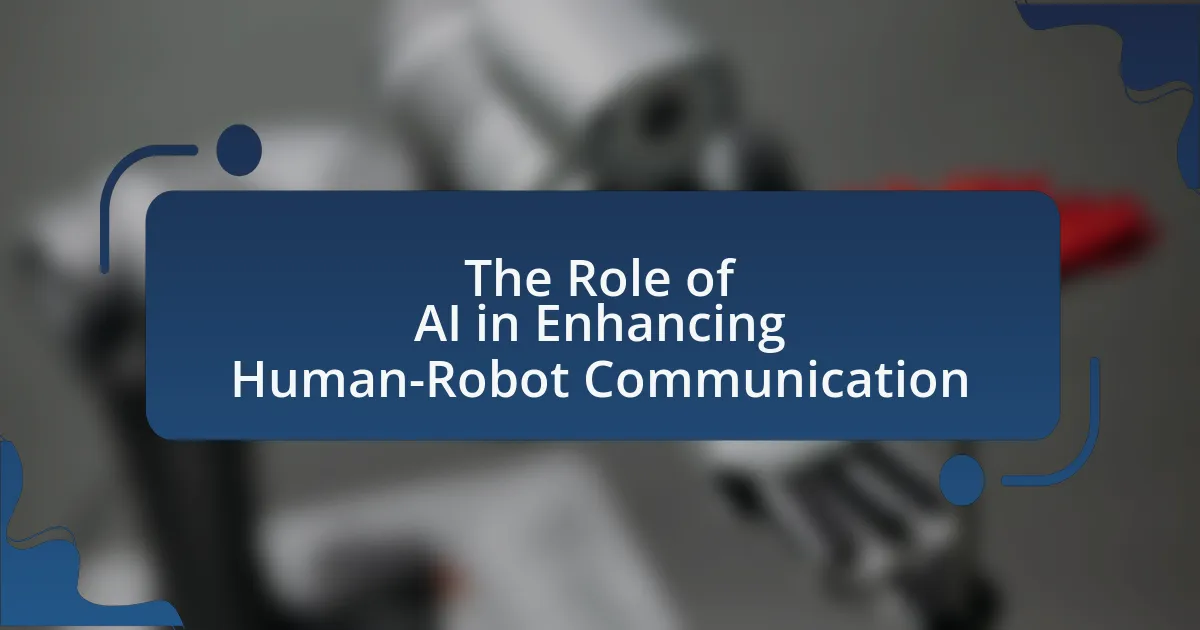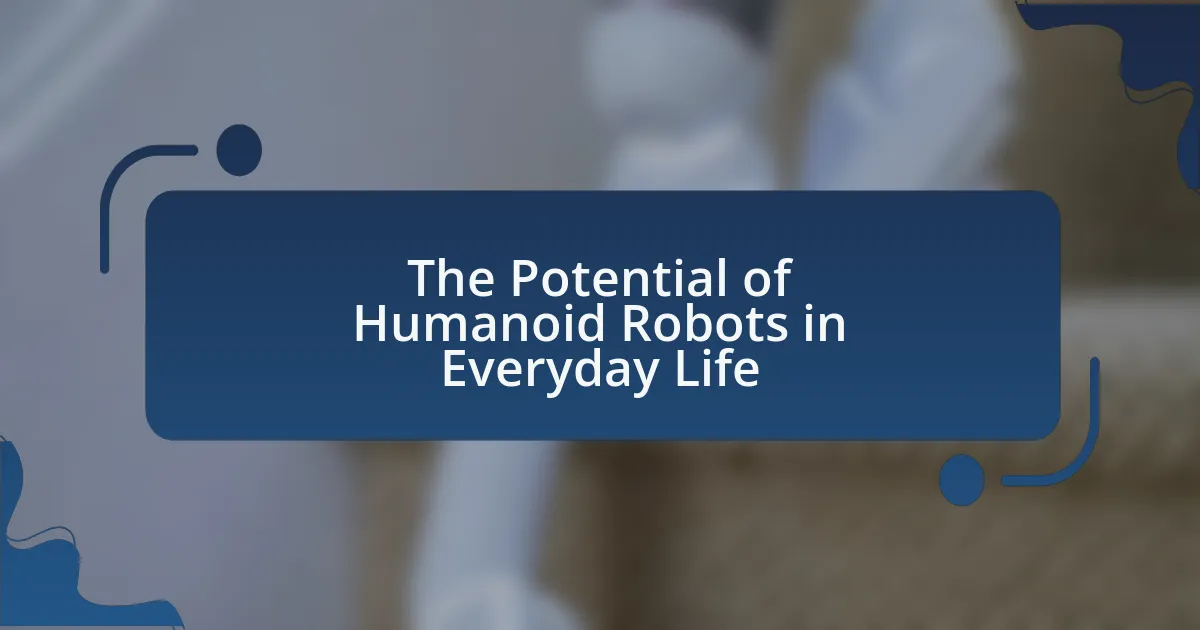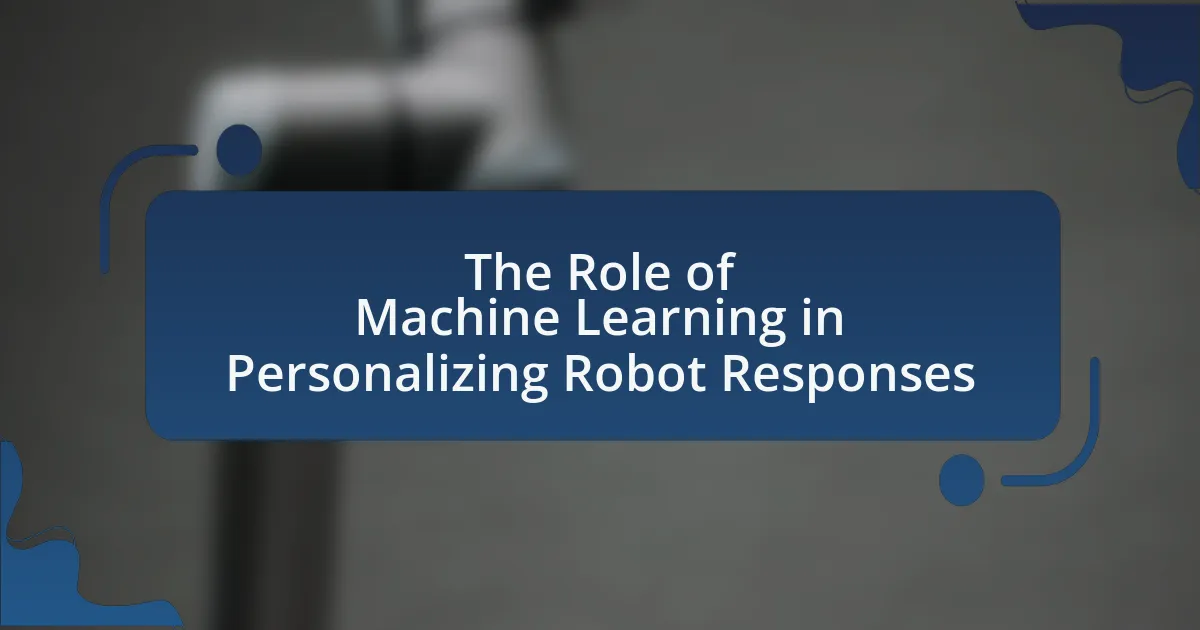Robotics is significantly transforming customer service experiences through automation and enhanced efficiency. Key technologies such as artificial intelligence, machine learning, and natural language processing enable robots to handle inquiries, provide personalized recommendations, and improve response times. This integration not only reduces operational costs and wait times but also allows human agents to focus on complex issues, ultimately leading to higher customer satisfaction. The article explores the essential role of robotics in various industries, the challenges it addresses in traditional customer service, and the future trends shaping this evolving landscape.
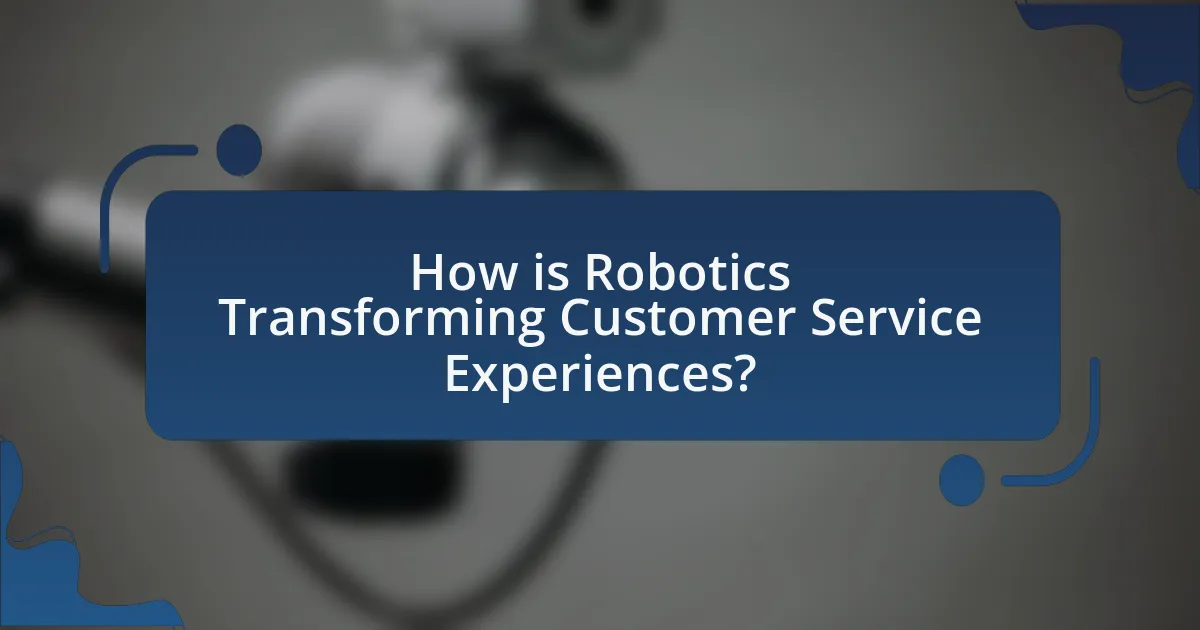
How is Robotics Transforming Customer Service Experiences?
Robotics is transforming customer service experiences by automating interactions and improving efficiency. Robots, such as chatbots and virtual assistants, handle customer inquiries 24/7, significantly reducing wait times and enhancing accessibility. For instance, a study by Juniper Research found that chatbots could save businesses over $8 billion annually by 2022 through improved customer service efficiency. Additionally, robots can analyze customer data to provide personalized recommendations, leading to higher customer satisfaction rates. This integration of robotics not only streamlines operations but also allows human agents to focus on more complex issues, thereby improving overall service quality.
What are the key technologies driving robotics in customer service?
Key technologies driving robotics in customer service include artificial intelligence (AI), machine learning, natural language processing (NLP), and robotic process automation (RPA). AI enables robots to understand and respond to customer inquiries effectively, while machine learning allows them to improve their responses over time based on customer interactions. NLP facilitates seamless communication between robots and customers by enabling the interpretation of human language. RPA automates repetitive tasks, enhancing efficiency in service delivery. These technologies collectively enhance customer experiences by providing quick, accurate, and personalized service.
How do AI and machine learning enhance robotic capabilities?
AI and machine learning enhance robotic capabilities by enabling robots to learn from data, adapt to new environments, and improve their decision-making processes. These technologies allow robots to analyze vast amounts of information, recognize patterns, and make predictions, which significantly increases their efficiency and effectiveness in tasks such as customer service. For instance, robots equipped with AI can understand and respond to customer inquiries in real-time, providing personalized assistance based on previous interactions. This capability is supported by studies showing that AI-driven robots can improve response accuracy by up to 90%, thereby transforming customer service experiences.
What role does natural language processing play in customer interactions?
Natural language processing (NLP) enhances customer interactions by enabling machines to understand, interpret, and respond to human language in a meaningful way. This technology facilitates real-time communication through chatbots and virtual assistants, allowing businesses to provide immediate support and personalized experiences. For instance, a study by McKinsey found that companies using NLP in customer service can reduce response times by up to 80%, significantly improving customer satisfaction. Additionally, NLP analyzes customer feedback and sentiment, helping businesses tailor their services to meet customer needs effectively.
Why is robotics becoming essential in customer service?
Robotics is becoming essential in customer service due to its ability to enhance efficiency and improve customer experiences. Automated systems, such as chatbots and robotic process automation, can handle a high volume of inquiries simultaneously, reducing wait times and increasing service availability. According to a report by McKinsey, businesses that implement automation in customer service can achieve up to a 30% reduction in operational costs while improving response accuracy. This efficiency allows human agents to focus on more complex issues, ultimately leading to higher customer satisfaction and loyalty.
What challenges in traditional customer service does robotics address?
Robotics addresses several challenges in traditional customer service, including high operational costs, limited availability, and inconsistent service quality. By automating routine tasks, robots reduce labor costs and allow businesses to allocate resources more efficiently. For instance, a study by McKinsey & Company found that automation can lead to a 20-30% reduction in operational costs. Additionally, robotics enables 24/7 service availability, overcoming the limitations of human staffing, which is often restricted by working hours. Furthermore, robots provide consistent responses and service quality, minimizing human error and variability, which enhances customer satisfaction.
How does robotics improve efficiency and response times?
Robotics improves efficiency and response times by automating repetitive tasks and enabling faster data processing. For instance, robotic process automation (RPA) can handle customer inquiries and transactions at a speed that far exceeds human capabilities, reducing response times from hours to seconds. According to a study by McKinsey, companies that implement robotics in customer service can achieve up to a 30% increase in operational efficiency, allowing human agents to focus on more complex issues. This integration of robotics not only streamlines workflows but also enhances customer satisfaction through quicker service delivery.
What are the potential impacts of robotics on customer satisfaction?
Robotics can significantly enhance customer satisfaction by improving service efficiency, accuracy, and personalization. Automated systems, such as chatbots and service robots, provide instant responses and 24/7 availability, which leads to reduced wait times and increased convenience for customers. A study by PwC found that 79% of consumers prefer to interact with a brand that uses AI for customer service, indicating a strong preference for robotic assistance. Additionally, robotics can minimize human error, ensuring that customer inquiries are handled correctly, which further boosts satisfaction levels. The integration of robotics in customer service not only streamlines operations but also creates a more engaging and responsive experience for customers.
How do robots personalize customer interactions?
Robots personalize customer interactions by utilizing artificial intelligence and machine learning algorithms to analyze customer data and preferences. These technologies enable robots to tailor responses, recommendations, and services based on individual customer profiles, enhancing engagement and satisfaction. For instance, chatbots can access previous interactions and purchase history to provide relevant suggestions, leading to a more customized experience. Research indicates that personalized interactions can increase customer satisfaction by up to 20%, demonstrating the effectiveness of robots in creating meaningful connections with customers.
What feedback mechanisms are in place to measure customer satisfaction with robotics?
Feedback mechanisms to measure customer satisfaction with robotics include surveys, user experience analytics, and direct feedback channels. Surveys, often conducted post-interaction, gather quantitative data on customer satisfaction levels, while user experience analytics track engagement metrics and interaction patterns with robotic systems. Direct feedback channels, such as chatbots or customer service interfaces, allow customers to provide real-time feedback on their experiences. These methods collectively enable organizations to assess and improve robotic services, ensuring they meet customer expectations effectively.
How are businesses implementing robotics in customer service?
Businesses are implementing robotics in customer service by utilizing chatbots and automated systems to handle inquiries and support tasks. These robotic solutions enable companies to provide 24/7 assistance, significantly reducing response times and operational costs. For instance, a study by Juniper Research indicates that chatbots will help businesses save over $8 billion annually by 2022 through improved efficiency and customer engagement. Additionally, companies like Amazon and Starbucks have integrated robotics into their customer service frameworks, enhancing user experience and streamlining processes.
What industries are leading the way in robotic customer service applications?
The industries leading the way in robotic customer service applications are retail, hospitality, and healthcare. Retail companies utilize robots for inventory management and customer assistance, enhancing the shopping experience. In hospitality, robots serve as concierges and room service providers, improving efficiency and customer satisfaction. Healthcare organizations employ robotic systems for patient interaction and administrative tasks, streamlining operations and enhancing patient care. These industries demonstrate significant advancements in integrating robotic technology to improve customer service experiences.
How are retail and e-commerce sectors utilizing robotics?
Retail and e-commerce sectors are utilizing robotics to enhance efficiency, streamline operations, and improve customer service. For instance, robots are deployed in warehouses for inventory management, picking, and packing, which significantly reduces processing time and labor costs. According to a report by McKinsey, automation in warehouses can increase productivity by up to 30%. Additionally, retail stores are using robots for customer assistance, inventory tracking, and even checkout processes, which enhances the shopping experience and reduces wait times. A study by ABI Research indicates that the use of service robots in retail could reach a market value of $12 billion by 2025, demonstrating the growing reliance on robotics in these sectors.
What examples exist in the hospitality industry for robotic customer service?
Robotic customer service in the hospitality industry includes examples such as the use of robots for room service delivery, concierge services, and cleaning tasks. For instance, the Henn-na Hotel in Japan employs robots for check-in, luggage handling, and room service, showcasing a fully automated guest experience. Additionally, the Aloft Hotels chain features the Botlr robot, which delivers amenities to guests’ rooms, enhancing convenience and efficiency. These implementations demonstrate how robotics is effectively transforming customer service experiences by improving operational efficiency and guest satisfaction.
What are the future trends in robotics for customer service?
Future trends in robotics for customer service include increased use of AI-driven chatbots, enhanced human-robot collaboration, and the deployment of autonomous service robots. AI-driven chatbots are expected to become more sophisticated, utilizing natural language processing to provide personalized customer interactions, as evidenced by the growing adoption of AI technologies in customer service, which is projected to reach a market size of $1.34 billion by 2024. Enhanced human-robot collaboration will allow robots to assist human agents in complex tasks, improving efficiency and customer satisfaction. Additionally, autonomous service robots, such as delivery drones and in-store assistants, are anticipated to become commonplace, with a projected market growth rate of 20% annually through 2025, reflecting the increasing demand for automation in customer service environments.
How might advancements in robotics change customer service roles?
Advancements in robotics are likely to automate routine tasks in customer service roles, leading to increased efficiency and reduced operational costs. For instance, robots can handle inquiries through chatbots or virtual assistants, providing immediate responses to common questions, which allows human agents to focus on more complex issues. According to a report by McKinsey, automation could increase productivity in customer service by up to 40%, demonstrating the potential for robotics to enhance service delivery while maintaining customer satisfaction.
What ethical considerations arise with the use of robotics in customer service?
The ethical considerations arising from the use of robotics in customer service include issues of privacy, job displacement, and accountability. Privacy concerns stem from the collection and handling of personal data by robotic systems, which can lead to unauthorized access or misuse of sensitive information. Job displacement is a significant ethical issue, as the automation of customer service roles may lead to unemployment for human workers, raising questions about the societal impact of such technology. Accountability becomes critical when robots make decisions or errors; determining who is responsible for these actions—whether the company, the developers, or the robots themselves—poses ethical dilemmas. These considerations highlight the need for clear guidelines and regulations to ensure that the deployment of robotics in customer service is conducted ethically and responsibly.
What best practices should businesses follow when integrating robotics into customer service?
Businesses should prioritize user experience, data security, and continuous training when integrating robotics into customer service. Focusing on user experience ensures that robotic systems are designed to meet customer needs effectively, enhancing satisfaction and engagement. Data security is crucial, as protecting customer information builds trust and complies with regulations; for instance, 60% of consumers are concerned about data privacy when interacting with automated systems. Continuous training of both staff and robots is essential to adapt to evolving customer expectations and technology, as ongoing education can improve service quality and operational efficiency. These best practices collectively contribute to a successful integration of robotics in customer service.
